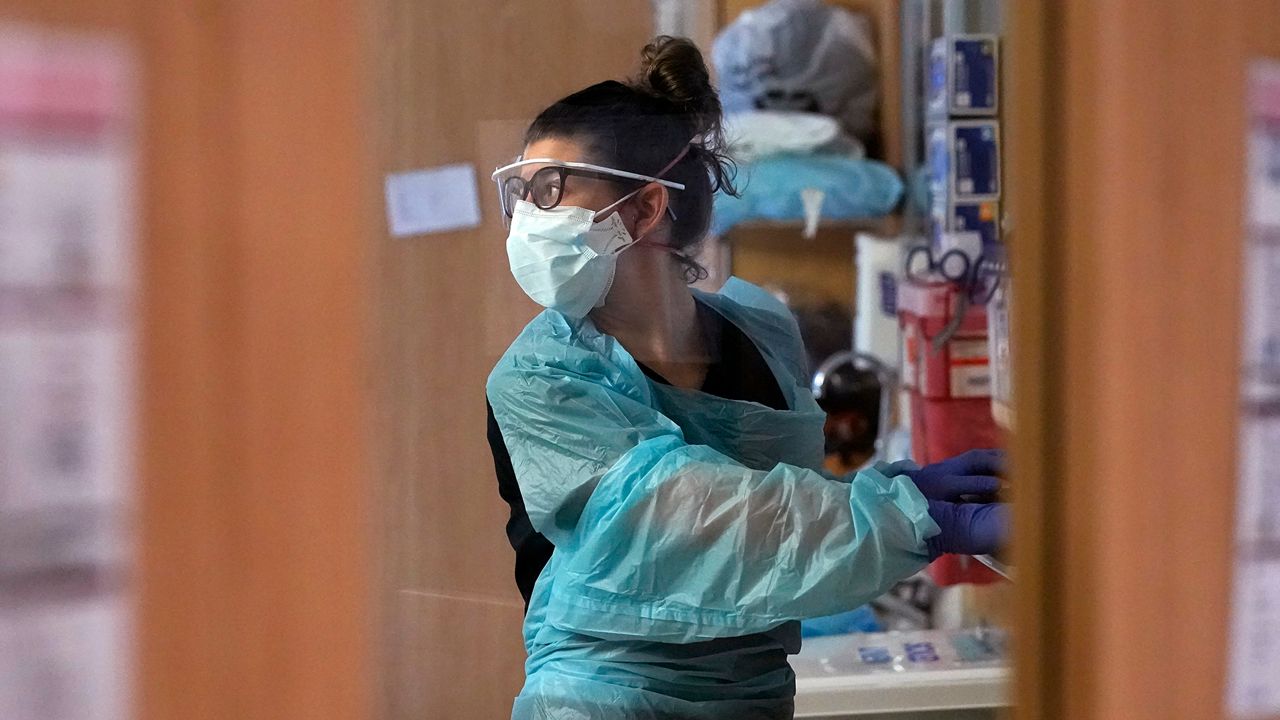COLUMBUS, Ohio — Health care workers in some Ohio hospitals are working through mild COVID-19 cases due to the medical staffing crisis and high virus-patient volumes.
What You Need To Know
- CDC guidelines allow infected health care staff to work during a staffing crisis
- Officials at Mercy Health, the largest health system in the state, said these protocols are in use
- Other hospitals are using five-day quarantines for employees who contract COVID-19
Hospital officials have adopted “crisis” strategies in accordance with the latest Centers for Disease Control and Prevention guidance for health care facilities coping with severe staffing shortages.
At Mercy Health, the largest health care system in the state, employees who test positive can work if they don’t have serious symptoms, officials said.
“Given the current volume in our communities and the severe strain on our staff and facilities, we have updated our employee return-to-work guidelines for COVID-19 positive employees who are asymptomatic, or have mild symptoms. If those employees feel well enough to fulfill their role, they can now return to work as soon as they choose to do so,” spokesperson Jennifer Robinson said.
Officials said they have taken “extraordinary steps” due to the challenges amid the latest virus surge. Mercy Health stressed its strict policies for positive employees to wear N95 masks at all times for 10 days after symptoms begin. They can only take their masks off during breaks and meals off premises, for example, in their cars. Employees who are positive are also not working with immunocompromised patients, officials said.
Health officials are hopeful that patient numbers will drop to manageable levels in the coming weeks, allowing for a return to longer isolation periods. COVID-19 hospitalizations in Ohio have declined by 21.1% in the last two weeks. Even still, more patients were hospitalized with COVID-19 in Ohio on Monday than at any previous point before the emergence of the omicron variant.
Mercy Health has hospitals in the hard-hit Cincinnati and Springfield areas, where the Ohio National Guard is bolstering its presence. Nearly two dozen Guard members are working at Springfield Regional Medical Center in clinical and non-clinical roles, Robinson said.
On Monday, 70 additional Ohio National Guard service members arrived at the University of Cincinnati Medical Center, joining 20 others who were already supporting the hospital.
UC Health is operating under CDC “contingency” guidance for staffing shortages, which is a step below the “crisis” strategies. These protocols stipulate a five-day isolation period for infected staff, which is shorter than the guidance for conventional times — 10 days of isolation, or seven with a negative test.
“We are allowing COVID-positive employees to return to work five to nine days post-infection. They must be fever-free for 24 hours and symptom-free, or with improving symptoms. They must also test negative for COVID-19 on a rapid antigen test before they are cleared to return by employee health, and they must wear appropriate PPE while onsite,” spokesperson Amanda Nageleisen said.
The health system will return to a 10-day isolation requirement when staffing levels are normal, Nageleisen said.
More than 1,000 patients are hospitalized in the eight-county southwest Ohio region, according to the latest update from the Health Collaborative of Greater Cincinnati.
Nageleisen said most of the National Guard members are being deployed in non-clinical roles, like environmental services and patient transportation, among many other jobs. A team of 10 National Guard medics is working in the emergency department.
In addition to Mercy Health and UC Health, the state has deployed the National Guard during the second half of January to southern Ohio hospitals, including Premier Atrium Medical Center in Middletown, the Christ Hospital in Cincinnati and Adena Regional Medical Center in Chillicothe.
The National Guard has scaled back its presence in the Cleveland area, where the virus wave peaked earlier. As of Saturday, the National Guard had left all seven Cleveland Clinic hospitals in Cuyahoga County.
Earlier in the month, Cleveland Clinic officials said the health system was among the early adopters of the CDC’s “contingency” protocols for five-day quarantines. As the virus moved south, the Cleveland Clinic and other Cleveland health systems gave advice to central Ohio and southern Ohio hospitals about how to bring staff back to work on an accelerated timeline in the safest way possible.
According to the Ohio Hospital Association, the relaxed guidelines for hospitals facing staffing shortages has helped health systems in the state meet patients’ needs for care during the surge. The association is not keeping track of which hospitals have used the crisis standards that allow infected workers to continue working if their symptoms aren’t serious, spokesperson John Palmer said.



